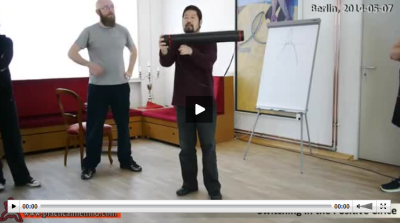讲解: 陈中华 片长: 10 分钟 语言:英文 年代: 2014 难度:3/5 地点:德国柏林。

In this video, Master Chen covered the 3 main axes in the body, and how we could switch among them without tossing in the positive circle, and the analogy of a lever with different pivots. We discussed about the shoulder last week at Shoulder Movements in Positive Circle, we will continue this week regarding switching with the lower half of the body.
After viewing the video, you should be able to answer the following questions:
1) What is switching?
2) What is being switched?
3) How can switching be achieved?
在此视频中,陈老师讲解了人体的三个主轴,和如何在不动的原则下在正圈中把它们转换,以及如何用不同支点的杠杆操作。 上周我们在正圈的肩视频中讨论了肩膀,我们将在本周继续讨论下身的转换动作。
这个视频教以下的课题:
1) 什么是换点?
2) 什么被转换?
3) 怎样完成转换?

学习了。还是有很多的陌生单词。看起来很费力气。
多看多听多练习就会变得容易。每个实用拳法视频的核心都是分阴阳。当有了实用拳法的概念,多听了英文的词汇就会很快上手。继续努力。
何教练,没有听懂,但是看明白了,讲支点在中轴和两个偏轴之间移动年。移动支点以后就加长了杠杆的力臂。视频最后讲丹田不动,动两个脚尖。
谢谢何教练上个视频的指导,昨晚我又把上个视频看多遍了。
不用客气。
8:23 Lastly, Master Chen demonstrated a switching exercise. Pressing down one heel caused the other heel to go up, and at all times, the dantian does not move at all. This resembled a tidder-todder (seesaw).
最后,陈老师示范了以个换点练习。 压下一只脚跟会使另一只脚跟抬起,并且在任何时候,丹田都不动。 像跷跷板一样。
7:40 Master Chen used the analogy of typing a keyboard to show the concept of separation (he used to call it division of labour too). Each finger is designated to type only certain keys on a keyword, there is no crossing or jumping around. The same key is always pressed by the same finger. The phrase 各家自扫门前雪 just came to my mind. Every finger contributes to typing certain letters, a word, a sentence and then a paragraph will come along. The typing will then be efficient. In our body, if we want to increase the distance between the front hand and the rear foot, each body part in between will have its own function to contribute to that end goal.
陈老师用打字键盘的实例来表示分开动作的概念(他也称其为分工)。 指定每根手指仅负责键盘上特定的键,而不会重叠或过界。 始终用同一根手指按下相同的键。 我想到了“各家自扫门前雪”这句话。 每个手指键入特定字母,有助组成单词,句子,然后段落。 这样打字很有效。 在我们的身体中,如果我们想增加前手和后脚之间的距离,中间的每个身体部位都会发挥自己的作用,以实现最终目标。
7:05 One of the things Master Chen has repeatedly said in many occasions that we needed to change our habits.
陈老师在许多场合反复说过一件事,我们需要改变习惯。
6:40 When Master Chen demonstrated pulling the opponent, he switched from his right shoulder-to-kua axis to his left shoulder-to-kua axis. Note that his torso stayed inside a cylindrical enclosure with no tossing.
当陈老师示范拉对手时,他从右肩胯轴转换到左肩胯轴。 请注意他的上半身没有任何晃动并完全留在圆柱体中。
6:20 The theory of 1/3: When measured against the floor, front kua to middle of front foot is 1/3, front kua to rear kua is the second 1/3, and rear kua to the middle of rear foot is the last 1/3.
三三理论:在地板上测量时,前胯到前脚中间的距离是三分之一,前胯到后胯的距离是第二个三分之一,后胯到后脚中间距离是最后的三分之一。
5:45 Here is another demonstration of movement the entire structure forward. Note the separation between the bottom and top. When the feet move, the top stays erect and not moving. The top does not follow the movement of the bottom.
这是整个结构前进的另一个示范。 注意下半身和上半身之间的分开。 当脚移动时,上半身保持顶劲于不动。 上半身不会跟随下半身的动而晃。
5:00 Here is another demonstration of the switching of the axes in positive circle.
这是正圈中轴转换的另一个示范。
4:16 If we can’t reach the opponent, we must use our feet to move ourselves closer to the opponent. Note how Master Chen moved himself forward. The dang and two knees must form a triangle like a coat hanger that is solid in its shape. All movements must come from the feet (from knee down). The top must not move, like the chassis of a car, and only the wheels spin to carry the chassis around. Therefore, no leaning, no reach, no identation at the kua or waist.
如果我们离对手太远,我们必须用脚的移动整个人去靠近对手。 请注意陈老师如何前进。 档和两个膝盖必须形成一个三角形,就像衣架一样牢固。 所有运动都必须来自脚(膝盖以下)。 上半身不动,要能像汽车的底盘一样移动,只有轮子旋转才能带动底盘。 因此,上身不半能前倾,手不能过分伸出,前胯不能塌,腰不能弯。
3:15 Master Chen demonstrated how to apply this concept into the positive circle. In the first half of the positive circle, we use the front shoulder-to-kua line as the axis. The longer lever arm is from the shoulder-to-kua line to the rear foot. in the 2nd half of the positive circle, we switch to use the back should-to-kua line as the axis. This switching is done without any body movement or tossing. Do not learn to fight too early, as it takes a long time to get the taiji actions in us.
陈老师示范了如何将这个概念运用到正圈中。 在正圆的前半部分,我们使用前肩胯线作为轴。 较长的杠杆臂从肩胯线到后脚。 在正圈的后半部分,我们转换为使用后面肩胯线作为轴。 无需任何身体移动或晃动而完成此转换。 我们不要太早学习用力对抗,因为太极拳动作需要很长时间的训练去熟习。
2:00 We need to learn to switch between the two functional axes by moving the pivot to those axes. When the power arm of a lever is short, it has a long reach and the action is fast, but you need more strength to move the lever. When the power arm is long, it has a short reach and the action is slow, but it takes less effort to move the lever. By learning the three major positions of the pivot on a lever, we can eventually put the pivot anywhere on the lever. Not moving means establishing the pivot on a lever. The vertical axis allows a horizontal rotation.
我们需要学习通过将移动支点到两条轴进行转换。 当杠杆的力臂较短时,它的作用范围很长,动作很快,但是您需要更大的力量才能转动杠杆。 当力臂较长时,它的作用范围很短,动作很慢,但是控制杆所需的力较少。 通过学习支点在杠杆上的三个主要位置,我们最终可以将支点放在杠杆上的任何位置。 不动的意思是在杠杆上建立支点。 竖轴允许平(横)转。
1:00 We have 3 vertical lines in our body. The one in the middle from top of head down is called central equilibrium, but that is not functional. The other two functional lines are from each of the shoulders down.
我们的身体有三条垂直线。 从头顶向下的中间位置的一个位置称为中线,但它没有实际作用。 其他两条有用的是从两个肩到胯。
Welcome everyone to this video! I have provided the following guided reference. Please feel free to ask any questions related to the video.
欢迎大家观看这视频! 导读已在此发出。 请随时提出与视频有关的任何问题。